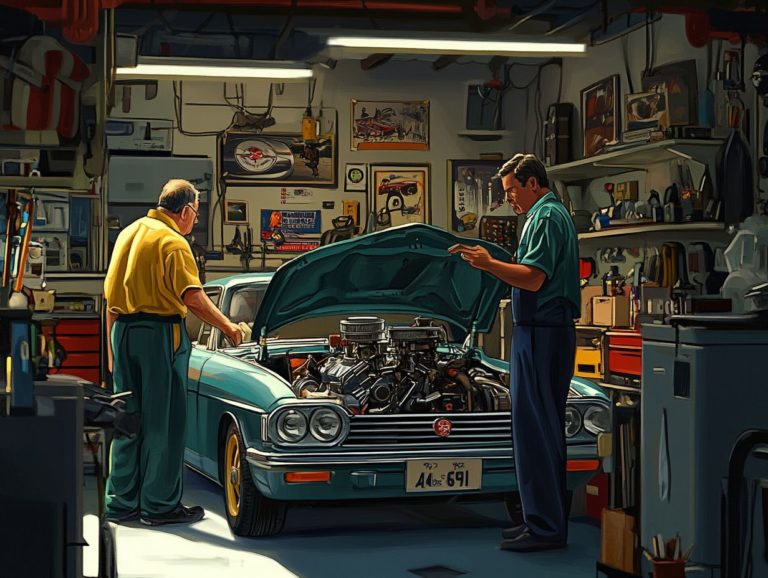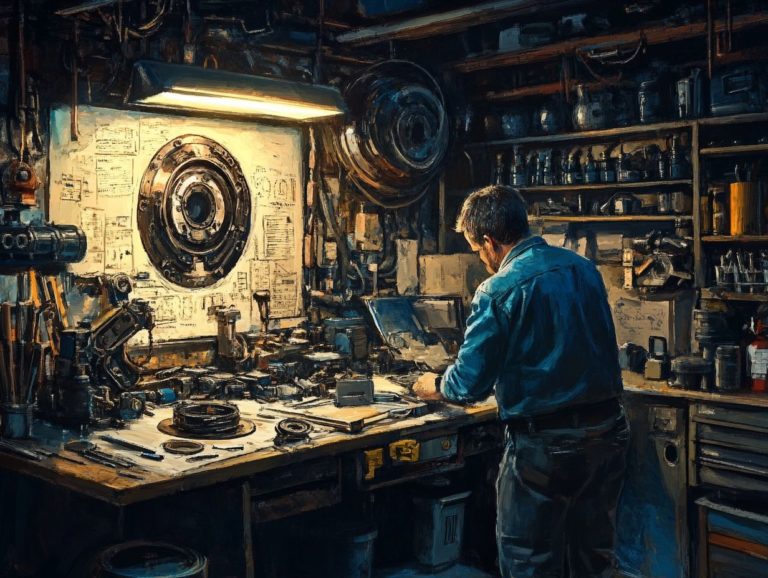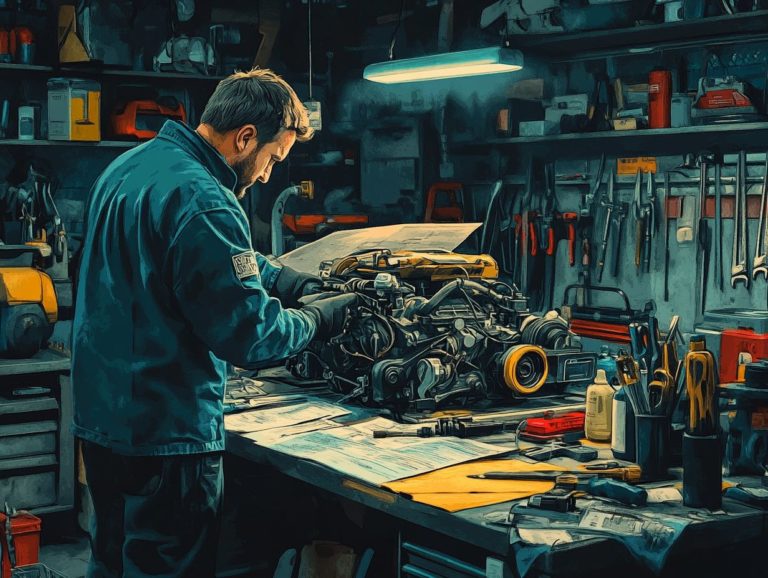5 Signs You Need to Repair Your Suspension
Is your car delivering a bumpy ride or veering to one side? These might be the telltale signs that your suspension system is in distress!
A properly functioning suspension helps keep your car steady and comfortable on the road. Ignoring these warning signs could lead to more significant problems in the future.
This article explores five critical indicators that your suspension may need repair, explains how the suspension operates, and offers maintenance tips to keep your ride comfortable and secure.
Stay engaged to ensure your vehicle performs at its peak!
Contents
- Essential Points to Remember!
- 1. Your Car is Pulling to One Side
- 2. You Feel Every Bump and Dip in the Road
- 3. Your Car Is Leaning or Sagging
- Maintenance Tips
- 4. Unusual Noises When Driving
- 5. Uneven Tire Wear
- What Is a Car Suspension and How Does It Work?
- Frequently Asked Questions
- What are the 5 signs that indicate I need to repair my suspension?
- Is uneven tire wear a sign that my suspension needs to be repaired?
- What does it mean if my car is pulling to one side while I’m driving?
- Why do I feel excessive bouncing or dipping when driving over bumps?
- What should I do if I experience steering wheel vibration while driving?
- Do I need to repair my suspension if my car’s nose dips when I brake?
Essential Points to Remember!

- Don’t ignore a car that pulls to one side or feels bumpy; it could be a sign of suspension damage.
- If your car is leaning or sagging, it’s time to get your suspension repaired!
- Unusual noises while driving can indicate suspension issues.
1. Your Car is Pulling to One Side
If you notice your car pulling to one side while driving, it s a clear signal that there may be underlying suspension issues. These problems often stem from worn suspension components or misalignment, affecting your control and safety on the road.
Ignoring these signs makes the problem worse and could lead to severe repairs and safety risks.
Additionally, uneven tire wear can contribute to this unsettling situation. Tires that wear unevenly not only diminish traction but can also create a drift that s increasingly difficult to manage.
Regular inspections at reputable auto shops, like Chapel Hill Tire, are essential for catching these issues before they escalate. Unaddressed symptoms could lead to more extensive mechanical problems and higher repair costs.
2. You Feel Every Bump and Dip in the Road
Feeling every bump and dip during your drive is usually a telltale sign that your suspension system isn t working properly. This sensation often arises from worn shock absorbers or inadequate suspension components, which can seriously compromise your vehicle s stability and comfort.
A malfunctioning suspension increases tire wear and diminishes handling capabilities. Shock absorbers help cushion the ride and keep your tires on the ground, making regular maintenance essential.
By monitoring for signs of wear and ensuring timely replacements, you can enjoy a smoother ride and greater safety on the road!
3. Your Car Is Leaning or Sagging
If you notice your car leaning or sagging to one side, it’s a signal that serious issues with the suspension may be at play. Problems like worn springs or damaged shock absorbers create an uneven ride, detracting from your driving experience.
These issues can significantly impact steering responsiveness and braking efficiency, increasing the risk of accidents. A vehicle that leans struggles to maintain traction during sharp turns or sudden stops.
Ignoring these warning signs worsens your driving conditions and can lead to costly repairs later on. Prioritize routine car maintenance and inspections to reduce such risks.
Turning to trusted auto shops like Chapel Hill Tire can help identify and resolve potential problems quickly, ensuring you maintain a safe and reliable vehicle.
Maintenance Tips
Regularly checking your suspension and addressing issues promptly is vital for your safety and comfort. Look out for signs like pulling, bumps, and uneven wear. Schedule inspections at trusted auto shops to keep your vehicle in prime condition!
4. Unusual Noises When Driving
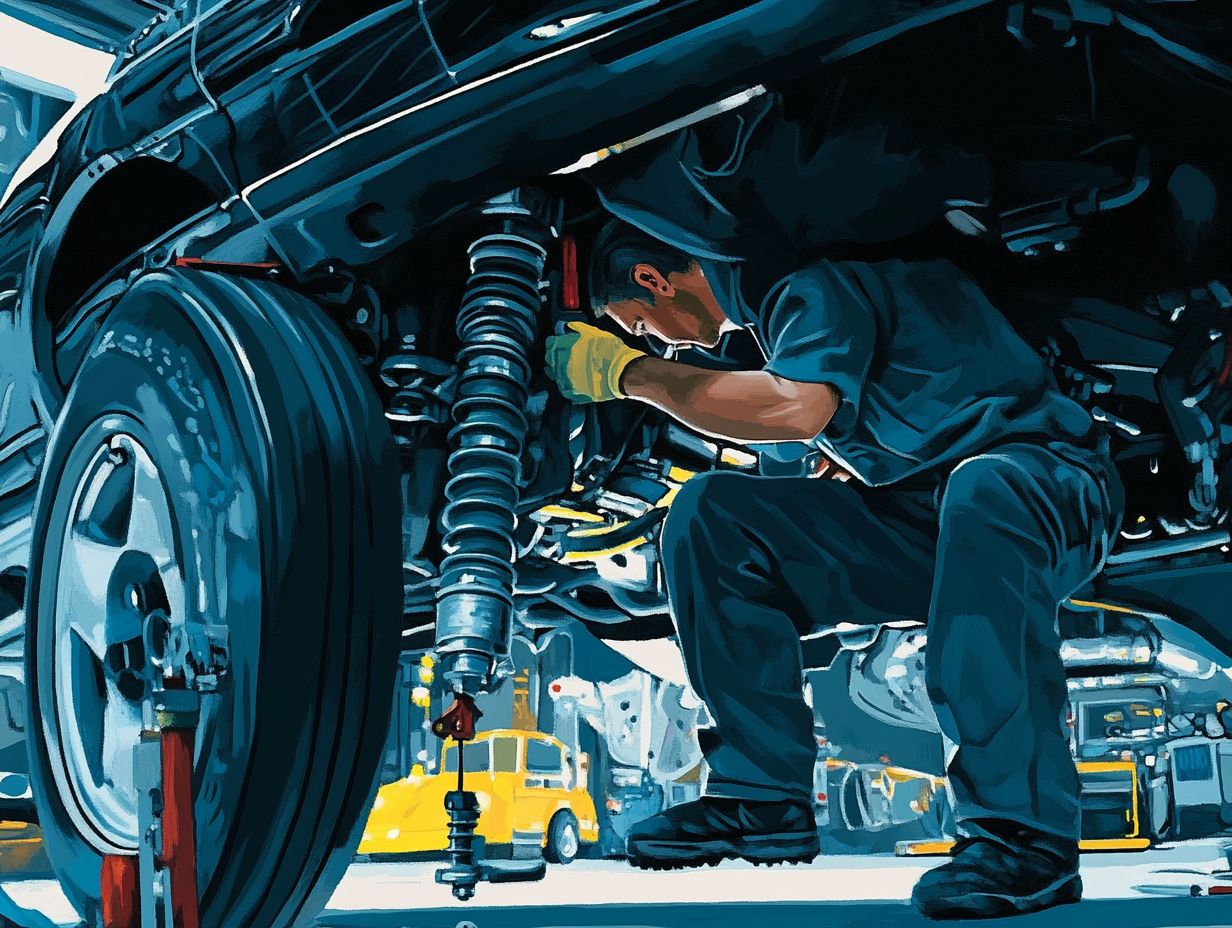
Experiencing unusual noises like knocking or clunking while driving can be alarming. These sounds often signal underlying suspension issues that require immediate attention. They may indicate worn or damaged suspension components, compromising your vehicle’s performance and your safety on the road.
If you hear a persistent grinding noise, it might mean that your shock absorbers are failing, leading to a rough ride and diminished handling. A high-pitched squeaking could suggest that the bushings are worn out or lacking lubrication, contributing to suspension instability.
Recognizing these symptoms is crucial. Don’t ignore them! Seeking the expertise of a professional mechanic can help you identify signs your car needs immediate maintenance and address any suspension problems promptly for both your safety and your vehicle’s longevity.
5. Uneven Tire Wear
Uneven tire wear is a crucial warning sign that your vehicle might be experiencing suspension issues. This can drastically impact steering responsiveness and overall control. The condition can stem from misaligned suspension components or worn shocks, leading to an unsafe driving experience.
Look for irregular patterns like one-sided wear, center wear, or scalloping. These often point to underlying suspension problems that need immediate attention. Such wear patterns can compromise not only the integrity of your tires but also the safety of everyone on the road.
Regular auto maintenance, including comprehensive inspections of both tires and suspension systems, is essential. Proactive checks can prevent further damage, significantly extend the life of your tires, and enhance your driving stability.
What Is a Car Suspension and How Does It Work?
A car suspension system is a collection of components designed to support your vehicle’s weight, absorb shocks from the road, and enhance overall stability and handling while you drive. Essential parts include shock absorbers, springs, and other suspension components that work together for a smoother and more comfortable driving experience.
Shock absorbers control the bounce of your vehicle, while the springs support its weight and maintain ideal ride height. Components like control arms and stabilizer bars work to eliminate body roll during cornering, significantly enhancing your road handling.
When all these elements interact seamlessly, they provide better traction and a cushioned ride, crucial for your comfort and safety. Neglecting maintenance can lead to premature wear and tear, resulting in reduced performance and a less stable driving experience, ultimately putting your safety at risk.
What Are the Common Causes of Suspension Damage?
- Everyday wear and tear
- Potholes
- Rough road conditions
- Aggressive driving habits (e.g., speeding over bumps)
- Road debris
- Poorly maintained streets
By understanding these causes, you can take a proactive approach to auto maintenance and address potential issues before they escalate. Regular inspections are key to catching these issues early.
Prioritizing maintenance extends the life of your suspension system and enhances overall road safety. This ensures a smoother ride and improved handling in various driving conditions.
If you notice unusual noises or uneven tire wear, visit a trusted mechanic today to ensure your safety.
How Can Suspension Problems Affect Your Driving Experience?

Suspension problems can significantly impact your driving experience. They can lead to decreased vehicle stability, reduced steering responsiveness, and a rough ride that undermines comfort.
These issues not only compromise your vehicle’s performance but also pose serious road safety risks.
For example, when you hit a pothole or encounter uneven pavement, the jolt can cause noticeable misalignment in your steering wheel. If your car’s shocks and struts which help absorb bumps are worn out, you might feel your car swaying excessively during turns.
This swaying can make it difficult to maintain control. Inadequate suspension extends your braking distances, making it harder for your vehicle to stay in contact with the road.
This not only detracts from overall comfort but can also create a dangerous situation during sudden stops. Recognizing these signs early and addressing them promptly is crucial for ensuring a safe and enjoyable driving experience.
What Are the Different Types of Suspension Systems?
There are several types of suspension systems, each crafted to deliver distinct levels of vehicle control, ride comfort, and handling characteristics.
Understanding these systems can guide you in selecting the perfect vehicle for your driving needs and preferences.
Suspension systems can primarily be divided into independent and dependent types. Independent suspension allows each wheel to move on its own, providing enhanced comfort and a smoother ride, especially on bumpy roads.
Dependent suspension connects the wheels. This can improve stability during cornering but might sacrifice ride quality.
It’s important to evaluate both systems, as each has its unique set of advantages and disadvantages.
For example, independent suspension might offer a more comfortable experience in urban driving, while dependent systems could excel on rugged terrains, where stability and durability are key.
Ultimately, your choice of suspension influences how your vehicle handles, responds to steering input, and ensures passenger comfort.
How Often Should You Get Your Suspension Checked?
Make it a priority to get an inspection every 12,000 to 15,000 miles or whenever you notice signs of suspension issues. Regular checks are essential for maintaining safety and performance.
Factors like driving conditions, how often you go off-road, and the load you carry can mean you need more frequent inspections.
If you’re navigating rough terrains or constantly encountering potholes, your suspension may need a check much sooner.
Choosing a reputable auto shop can be a lifesaver for you and your passengers! Skilled mechanics can spot issues that might escape the notice of the average driver.
This ensures the safety of both your vehicle and its passengers.
What Are the Benefits of Regular Suspension Maintenance?
Regular suspension maintenance provides you with a wealth of benefits. These include improved vehicle control, enhanced stability, and a smoother ride that significantly contributes to your road safety.
By ensuring that all suspension components are functioning optimally, you can enjoy a comfortable driving experience while avoiding costly repairs later on.
Consistent maintenance is vital for your vehicle’s overall longevity. A well-maintained suspension system helps maintain tire alignment and promotes even tire wear.
This leads to better fuel efficiency. By tackling minor issues early, you can prevent them from escalating into major repairs that could seriously dent your finances.
Investing your time and resources in preventative maintenance offers you peace of mind. It ensures your vehicle remains safe and efficient while shielding your wallet from unexpected financial burdens.
Schedule your suspension check-up today to ensure safety on the road!
Frequently Asked Questions
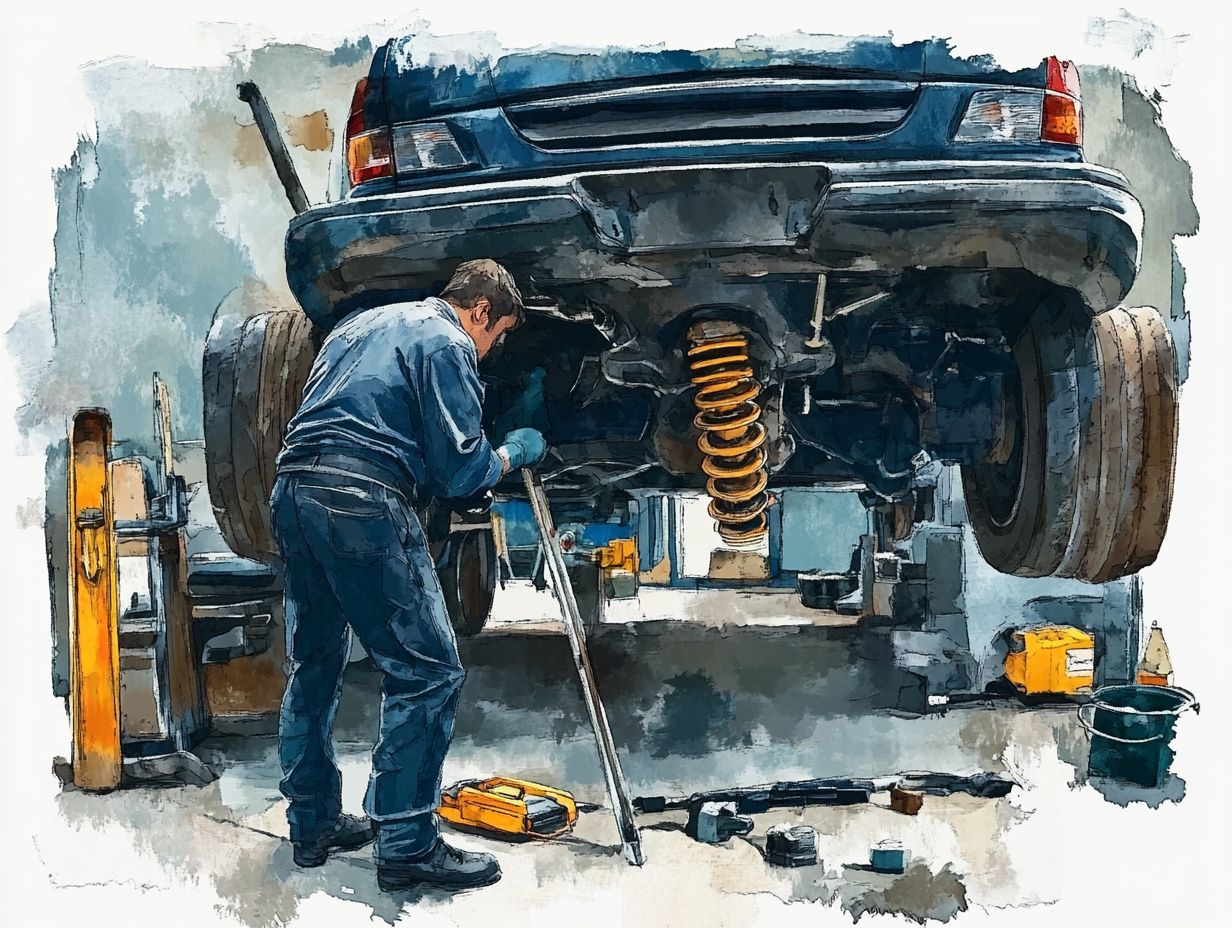
What are the 5 signs that indicate I need to repair my suspension?
Wondering if your suspension is in trouble? Look for these 5 signs you need to visit a mechanic: uneven tire wear, pulling to one side while driving, excessive bouncing or dipping over bumps, steering wheel vibration, and the car’s nose dipping when you brake.
Is uneven tire wear a sign that my suspension needs to be repaired?
Yes! Uneven tire wear is a key indicator. It suggests that your suspension components might be worn out.
What does it mean if my car is pulling to one side while I’m driving?
If your car pulls to one side, it could signal suspension issues. This often happens due to uneven suspension or wheels that aren’t lined up correctly.
Why do I feel excessive bouncing or dipping when driving over bumps?
Feeling excessive bouncing? It might be due to worn shocks or struts. Don t ignore this; it can make your car unstable.
What should I do if I experience steering wheel vibration while driving?
Steering wheel vibration is not normal. It can indicate suspension problems, such as worn components or misaligned wheels. Get it checked out soon!
Do I need to repair my suspension if my car’s nose dips when I brake?
Absolutely! If your car’s nose dips when you brake, it s a sign of suspension issues. Address it quickly to maintain safe braking performance.


